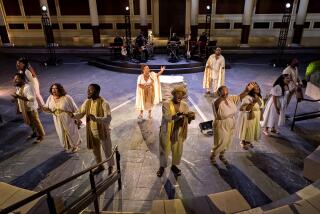Music and Dance Reviews : Melodrama of ‘Orphee’ in Cocteau Festival
- Share via
As part of the ongoing Jean Cocteau Centenary Festival, choreographer Tony Clark turned to a problematic art form--the melodrama--for his “Orphee, Oedipus and the Lady With the Red Gloves,” seen Friday at the Gallery Theatre in Barnsdall Park.
Long associated with musical composition in Germany and France, melodrama is distinguished as a form by the use of an actor who speaks instead of sings. It runs the risk of satisfying neither those interested in dramatic recitation nor those interested in singing--or, in this case, dancing. It can bog down by first telling you what you are about to see, then showing you.
Clark, executive director of the Severin Wunderman Museum in Irvine (which houses a large collection of Cocteau artwork), did not escape these pitfalls.
Further, because the action involved the very personal spin Cocteau put onto literary and mythological figures such as Orpheus or Oedipus--plus inventing some of his own, the Angel Heurtebise or the Lady With the Red Gloves (Death)--the whole experience became hermetic and etiolated.
Amid decors that included Aubusson’s tapestry, “Judith and Holophernes,” based on a Cocteau design, Clark moved his dancers in stop-and-go balletic chase-and-fight sequences to taped excerpts from Messiaen’s “Turangalila-symphonie.”
The plot had something to do with whether Orphee could find his perfect inspiration (Angel Heurtebise) before Death (Lady With the Red Gloves) outwitted protector Oedipus.
Leonard John Crofoot was the nimble, much-sought-after Orphee; the long-limbed Sean Carey, his watchful Oedipus. Elspeth Kuang was the devouring Lady; James Maxwell, the briefly-seen, bare-chested Angel Heurtebise.
Carl Hermanns, who conducts pops programs with the San Diego Symphony, narrated the sometimes opaque narratives by William Emboden.
More to Read
The biggest entertainment stories
Get our big stories about Hollywood, film, television, music, arts, culture and more right in your inbox as soon as they publish.
You may occasionally receive promotional content from the Los Angeles Times.










